View in other NatureServe Network Field Guides
NatureServe
Montana
Utah
Wyoming
Idaho
Wisconsin
British Columbia
South Carolina
Yukon
California
New York
Nine-anther prairie clover - Dalea enneandra
State Rank Reason (see State Rank above)
In Montana, known from a few poorly documented occurrences in the eastern half of the state. Additional surveys and updated population data are needed.
- Details on Status Ranking and Review
Population Size
Score2-3 - Very Small to Small: Population size is imprecisely known but is believed to be <10,000 individuals.
CommentPopulation levels are undocumented though appear to be small.
Range Extent
Score1 - Peripheral, Disjunct or Sporadic Distribution in MT: Widespread species that is peripheral, disjunct or sporadically distributed within MT such that it occurs in <5% of the state (<7,500 sq. miles or the combined area of Beaverhead and Ravalli Counties) or is restricted to 4-5 sub-basins.
Area of Occupancy
Score2 - Low: Generally occurring in 4-10 Subwatersheds (6th Code HUC’s).
CommentMost of the collection sites are from private lands.
Environmental Specificity
Score1 - Moderate: Species is restricted to a specific habitat that is more widely distributed or to several restricted habitats and is typically dependent upon relatively unaltered, good-quality habitat (C Values of 5-7).
CommentHabitat does not appear to be especially unique or rare.
Trends
ScoreNA - Rank factor not assessed.
CommentTrends are unknown, though there is no indication that the species' has experienced significant declines in Montana.
Threats
Score0-1 - Low to Medium.
CommentThreats to the species in Montana are not believed to be wide-ranging and/or high in severity or immediacy.
Intrinsic Vulnerability
Score0-1 - Low to Moderate Vulnerability.
Raw Conservation Status Score
Score
6 to 9 total points scored out of a possible 16 (Rarity factors and threats only).
General Description
Nine-anther Dalea is a perennial herb with 1-3 erect, branched stems, which are 5-10 dm tall and arise from a yellow taproot. The leaves are 13-26 mm long, lack petioles, and are pinnately divided into 2-6 pairs of narrowly elliptic leaflets. Foliage is glandular. The flowers lack stalks and are well separated in spikes at the branch tips. Each white, pea-like flower is 8-11 mm long and is surrounded at the base by a broad, deciduous bract that is 3-4 mm long and has pale margins. The calyx has 5 long, hairy, linear lobes that are 3-5 mm long. The upper petal is 6-7 mm long and only slightly reflexed; there are 9 stamens. The egg-shaped pod is 3-4 mm long and has one seed.
Phenology
Flowering July-September.
Diagnostic Characteristics
The combination of the long, hairy calyx and the 9 stamens separate this plant from other species of Dalea and from species of Psoralea and Amorpha.
Species Range
Montana Range
Range Descriptions
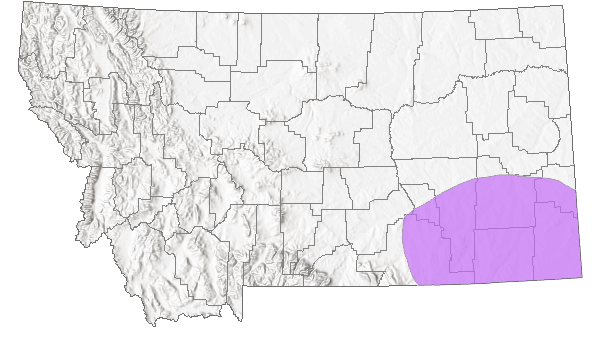
 Native
Native
Range Comments
Nine-anther prairie-clover is Great Plains species that is known from North Dakota south to New Mexico and Texas.
Observations in Montana Natural Heritage Program Database
Number of Observations: 15
(Click on the following maps and charts to see full sized version)
Map Help and Descriptions
Relative Density
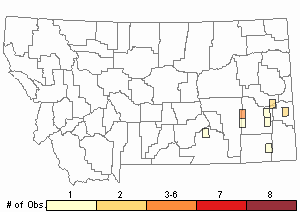
Recency
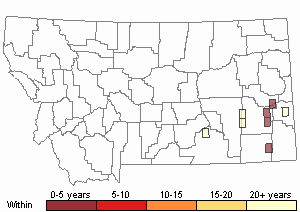
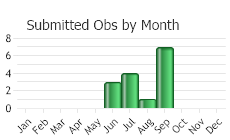
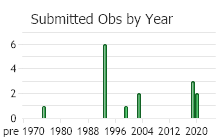
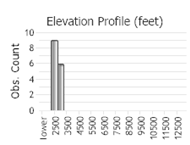 (Observations spanning multiple months or years are excluded from time charts)
(Observations spanning multiple months or years are excluded from time charts)
Habitat
Gravelly-soiled grasslands and slopes on the plains. Species associated with sites in Montana include Stipa comata, Elymus smithii, Carex filifolia, Calamovilfa longifolia, Cryptantha celosioides, Artemisia tridentata, Artemisia frigida and Yucca glauca.
Ecological Systems Associated with this Species
Ecology
POLLINATORS The following animal species have been reported as pollinators of this plant species or its genus where their geographic ranges overlap:
Bombus auricomus,
Bombus pensylvanicus,
Bombus griseocollis, and
Bombus impatiens (Colla and Dumesh 2010, Williams et al. 2014).
Threats or Limiting Factors
STATE THREAT SCORE REASON
Threat impact not assigned because threats are not known (MTNHP Threat Assessment 2021).
References
- Literature Cited AboveLegend:
 View Online Publication
View Online Publication Colla, S.R. and S. Dumesh. 2010. The bumble bees of southern Ontario: notes on natural history and distribution. Journal of the Entomological Society of Ontario 141:39-68.
Colla, S.R. and S. Dumesh. 2010. The bumble bees of southern Ontario: notes on natural history and distribution. Journal of the Entomological Society of Ontario 141:39-68. Williams, P., R. Thorp, L. Richardson, and S. Colla. 2014. Bumble Bees of North America. Princeton, NJ: Princeton University Press. 208 p.
Williams, P., R. Thorp, L. Richardson, and S. Colla. 2014. Bumble Bees of North America. Princeton, NJ: Princeton University Press. 208 p.
- Additional ReferencesLegend:
 View Online Publication
View Online Publication
Do you know of a citation we're missing? Heidel, B. 1990. Inventory of rare plant species in Theodore Roosevelt National Park, Billings and McKenzie counties, North Dakota. Report to the National Park Service. North Dakota Natural Heritage Inventory, Bismarck, North Dakota. 112 pp.
Heidel, B. 1990. Inventory of rare plant species in Theodore Roosevelt National Park, Billings and McKenzie counties, North Dakota. Report to the National Park Service. North Dakota Natural Heritage Inventory, Bismarck, North Dakota. 112 pp. Lesica, P., M.T. Lavin, and P.F. Stickney. 2012. Manual of Montana Vascular Plants. Fort Worth, TX: BRIT Press. viii + 771 p.
Lesica, P., M.T. Lavin, and P.F. Stickney. 2012. Manual of Montana Vascular Plants. Fort Worth, TX: BRIT Press. viii + 771 p. Lesica, P., M.T. Lavin, and P.F. Stickney. 2022. Manual of Montana Vascular Plants, Second Edition. Fort Worth, TX: BRIT Press. viii + 779 p.
Lesica, P., M.T. Lavin, and P.F. Stickney. 2022. Manual of Montana Vascular Plants, Second Edition. Fort Worth, TX: BRIT Press. viii + 779 p. North Dakota Natural Heritage Program. 1993. 1991-1992 inventory of rare plant species in the Little Missouri National Grasslands. Unpublished report to the Custer National Forest. Bismarck, North Dakota. 72 pp.
North Dakota Natural Heritage Program. 1993. 1991-1992 inventory of rare plant species in the Little Missouri National Grasslands. Unpublished report to the Custer National Forest. Bismarck, North Dakota. 72 pp.
- Web Search Engines for Articles on "Nine-anther prairie clover"





